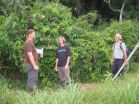(Press-News.org) Deep coral reefs in Papahanaumokuakea Marine National Monument (PMNM) may contain the highest percentage of fish species found nowhere else on Earth, according to a study by NOAA scientists published in the Bulletin of Marine Science. Part of the largest protected area in the United States, the islands, atolls and submerged habitats of the Northwestern Hawaiian Islands (NWHI) harbor unprecedented levels of biological diversity, underscoring the value in protecting this area, scientists said.
Hawaii is known for its high abundance of endemic species – that is, species not found anywhere else on Earth. Previous studies, based on scuba surveys in water less than 100 feet, determined that on average 21 percent of coral reef fish species in Hawaii are unique to the Hawaiian Archipelago.
However, in waters 100 to 300 feet deep, nearly 50 percent of the fish scientists observed over a two-year period in the monument were unique to Hawaii, a level higher than any other marine ecosystem in the world. The study also found that on some of PMNM's deeper reefs, more than 90 percent of fish were unique to the region. These habitats can only be accessed by highly trained divers using advanced technical diving methods.
"The richness of unique species in the NWHI validates the need to protect this area with the highest conservation measures available," said Randy Kosaki, PMNM's deputy superintendent and co-author of the study. "These findings also highlight the need for further survey work on the monument's deeper reefs, ecosystems that remain largely unexplored."
Data for the study was collected during two research expeditions to the NWHI aboard NOAA Ship Hi'ialakai in the summers of 2010 and 2012. Some of the unique fish species that were observed include: Redtail Wrasse (Anampses chrysocephalus), Thompson's Anthias (Pseudanthias thompsoni), Potter's Angelfish (Centropyge potteri), Hawaiian Squirrelfish (Sargocentron xantherythrum), Chocolate Dip Chromis (Chromis hanui), Masked Angelfish (Genicanthus personatus), and Blueline Butterflyfish (Chaetodon fremblii).
INFORMATION:
Co-authored by Cori Kane of Washington State University and PMNM staff members Randy Kosaki and Daniel Wagner, the paper, "High levels of mesophotic reef fish endemism in the Northwestern Hawaiian Islands," was published in the peer-reviewed scientific journal Bulletin of Marine Science and can be viewed online at http://www.ingentaconnect.com/content/umrsmas/bullmar/pre-prints/content-bms_9030;jsessionid=efn2b4j14hlb.alice. The print version of the journal will be available in April.
Papahanaumokuakea is cooperatively managed to ensure ecological integrity and achieve strong, long-term protection and perpetuation of Northwestern Hawaiian Island ecosystems, Native Hawaiian culture, and heritage resources for current and future generations. Three co-trustees - the Department of Commerce, Department of the Interior, and State of Hawai'i - joined by the Office of Hawaiian Affairs, protect this special place. Papahanaumokuakea Marine National Monument was inscribed as the first mixed (natural and cultural) UNESCO World Heritage Site in the United States in July 2010. For more information, please visit http://www.papahanaumokuakea.gov.
Fish species unique to Hawaii dominate deep coral reefs in Northwestern Hawaiian Islands
2014-03-13
ELSE PRESS RELEASES FROM THIS DATE:
Plant biology discovery furthers scientists' understanding of plant growth and development
2014-03-13
RIVERSIDE, Calif. — Auxin, a small molecule, is a plant hormone discovered by Charles Darwin about 100 years ago. Over the years that followed it became understood to be the most important and versatile plant hormone controlling nearly all aspects of plant growth and development, such as bending of shoots toward the source of light (as discovered by Darwin), formation of new leaves, flowers, and roots, growth of roots, and gravity-oriented growth. Just how a small molecule like auxin could play such a pivotal role in plants baffled plant biologists for decades.
Then, ...
Mid-level solar flare seen by NASA's SDO
2014-03-13
The sun emitted a mid-level solar flare, peaking at 6:34 p.m. EDT on March 12, 2014, and NASA's Solar Dynamics Observatory, or SDO, captured an image of it. Solar flares are powerful bursts of radiation. Harmful radiation from a flare cannot pass through Earth's atmosphere to physically affect humans on the ground, however -- when intense enough -- they can disturb the atmosphere in the layer where GPS and communications signals travel.
To see how this event may impact Earth, please visit NOAA's Space Weather Prediction Center at http://spaceweather.gov, the U.S. government's ...
Halting immune response could save brain cells after stroke
2014-03-13
MADISON — A new study in animals shows that using a compound to block the body's immune response greatly reduces disability after a stroke.
The study by scientists from the University of Wisconsin School of Medicine and Public Health also showed that particular immune cells – CD4+ T-cells produce a mediator, called interleukin (IL) -21 that can cause further damage in stroke tissue. Moreover, normal mice, ordinarily killed or disabled by an ischemic stroke, were given a shot of a compound that blocks the action of IL-21. Brain scans and brain sections showed that the ...
Condon publishes new research in Science
2014-03-13
A wasp's sting might explain it all.
Marty Condon, professor of biology at Cornell College, has been studying flies in the tropics for years, and in a paper published in Science this week, she reports evidence that there is more to a fly's ecological niche than where it lives and what it eats—you have to look at what eats the fly, as well.
In a previous Science paper, Condon and her co-researchers found that there were far more species of flies feeding on tropical flowers than expected. It was counter-intuitive, Condon said, to see so many species of flies filling what ...
Scripps Florida scientists devise new, lower cost method to create more usable fuels
2014-03-13
JUPITER, FL – March 13, 2014 – As the United States continues to lead the world in the production of natural gas, scientists from the Florida campus of The Scripps Research Institute (TSRI) have devised a new and more efficient method with the potential to convert the major components found in natural gas into useable fuels and chemicals—opening the door to cheaper, more abundant energy and materials with much lower emissions.
The research, which was led by TSRI Professor Roy Periana, uses clever chemistry and nontraditional materials to turn natural gas into liquid ...
Scripps Research Institute scientists discover a better way to make unnatural amino acids
2014-03-13
LA JOLLA, CA—March 13, 2014—Chemists at The Scripps Research Institute (TSRI) have devised a greatly improved technique for making amino acids not found in nature. These "unnatural" amino acids traditionally have been very difficult to synthesize, but are sought after by the pharmaceutical industry for their potential medical uses.
"This new technique offers a very quick way to prepare unnatural amino acids, many of which are drug candidates or building blocks for peptide drugs," said Jin-Quan Yu, a professor in TSRI's Department of Chemistry.
Yu's team has reported ...
Scientists find new way to upgrade natural gas
2014-03-13
America's current energy boom may take a new direction thanks to the discovery of a new way to turn raw natural gas into upgraded liquid alcohol fuel.
In the March 14 issue of Science magazine, chemists from Brigham Young University and The Scripps Research Institute detail a process that could reduce dependence on petroleum.
The most unexpected breakthrough in the paper was that ordinary "main group" metals like thallium and lead can trigger the conversion of natural gas to liquid alcohol. The research teams saw in experiments that natural gas to alcohol conversion ...
Stumbling fruit flies lead scientists to discover gene essential to sensing joint position
2014-03-13
LA JOLLA, CA—March 13, 2014—Scientists at The Scripps Research Institute (TSRI) have discovered an important mechanism underlying sensory feedback that guides balance and limb movements.
The finding, which the TSRI team uncovered in fruit flies, centers on a gene and a type of nerve cell required for detection of leg-joint angles. "These cells resemble human nerve cells that innervate joints," said team leader Professor Boaz Cook, who is an assistant professor at TSRI, "and they encode joint-angle information in the same way."
If the findings can be fully replicated ...
A novel battleground for plant-pathogen interactions
2014-03-13
Scientists at The Sainsbury Laboratory in Norwich, with collaborators at Michigan State University and the University of Illinois, have unveiled a new way in which plants perceive pathogens to activate immunity.
They also show how pathogens inhibit the mechanism to cause disease. It was previously only associated with other processes in mammalian cells.
When plants detect microbial molecules, they trigger immune responses to prevent disease. Although several plant immune receptors for these microbial molecules are known, how they are activated once the microbe is recognised ...
When big isn't better: How the flu bug bit Google
2014-03-13
Numbers and data can be critical tools in bringing complex issues into crisp focus. The understanding of diseases, for example, benefits from algorithms that help monitor their spread. But without context, a number may just be a number, or worse, misleading.
"The Parable of Google Flu: Traps in Big Data Analysis" is published in the journal Science, funded, in part, by a grant from the National Science Foundation. Specifically, the authors examine Google's data-aggregating tool Google Flu Trend (GFT), which was designed to provide real-time monitoring of flu cases around ...







